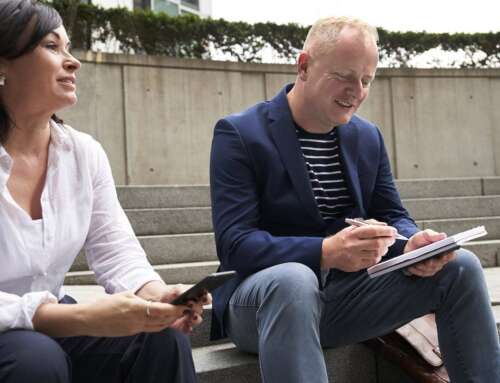Are you planning on creating a workshop? Many people envision a career in sex coaching as one-on-one sessions with clients. But there are so many other ways to help people, to get your message out, and to generate an income from your sex coaching practice. One popular option is to offer workshops because you can reach many people at once. Workshops are also an option for sex coaches in training. However, a good bit of planning goes into a successful workshop. Here are some basic elements you need to address in order to create and execute your workshop idea.
Before Creating a Workshop: Crafting & Planning
Before you begin creating a workshop, think about what you’re most excited to share with others. Maybe it’s something you recently discovered that has motivated you, or maybe it’s a topic that’s been near and dear to you for years.
Having an idea you’re passionate about is a great starting point. Let’s develop that idea into a full-blown workshop. The first two steps are identifying who your target audience is and what the objectives are. In other words, who would benefit from a workshop about this idea, and what, specifically, will they come away from this workshop having learned?
Here are some questions to guide you to answers about your audience and your objectives:
- Who am I addressing, and what are they gaining from this?
- What aspects of this topic make me enthused about teaching it?
- What are the implications if my audience had this information, or was able to see things this way?
- In what way will my guidance and knowledge in this topic potentially change their life?
- How could this workshop help solve a problem or address a common concern for this group of people?
Using SMART Objectives In Creating a Workshop
When you’re crafting your objectives, it’s helpful to use SMART criteria: Specific, Measurable, Achievable, Relevant, and Time-bound. Be very specific about who, what, how, and why you’re presenting this topic.
SPECIFIC: You may need to refine your idea so that you’re focusing on one aspect of a large topic. For example, maybe you want to talk about anatomy. That’s much too broad. So you might narrow it down to clitoral anatomy and the G-spot.
Now, to further refine your idea, consider who you’re presenting to. If your intended audience is heterosexual couples, your objective might be to help them bridge the orgasm gap. The same workshop topic could instead be geared toward heterosexual men and helping them figure out how to find the G-spot to satisfy their partner. This would be very different from the couples workshop. If you instead target women with the goal of helping them develop a better understanding of their bodies so they can enjoy sex more, the flow, feel, and subtopics would shift once again.
MEASURABLE: Thinking further about your SMART objectives, consider how you’ll know if participants met the objectives. Maybe you compile a list of ideas shared by participants during one of the activities, and that meets your second objective. Perhaps at the end, you ask each participant a question that addresses your first objective.
ACHIEVABLE: Make sure your objectives are relevant and realistic, too. For example, if your workshop addresses body image, can participants expect to have an entirely different outlook on their body from your 90-minute workshop? Probably not. Will they have 2 new tools they can practice to improve their body image? That’s much more attainable.
RELEVANT: It’s also crucial to make sure that the content of your workshop matches up with your objectives. Maybe you thought of a fabulous activity about the language of anatomy, but it doesn’t actually tie in with your objectives in any way. You either need to change the objectives and purpose of your workshop or ditch the irrelevant activity, no matter how fun and thought-provoking it may seem.
TIME-BOUND: Planning your time and the pace of each part of your workshop is important also. How long is each activity going to last? What’s the action plan if some parts take longer or shorter than planned? It’s especially important to consider what to do if a particular part takes longer than the time you’d allotted for it. You may need to abbreviate or eliminate later portions of your workshop, so you’ll need to determine in advance the most important elements you don’t want to skip over.
On the other hand, sometimes you race through your material and few or no people share. Or maybe it’s shorter because fewer people showed up. What will you do if you invite participants to share and no one does? Do you have back-up examples and ideas? Figure out how else you can fill the time, if necessary.
With online workshops, you have to allow enough silent time for people to think about the question, decide to share, and then either unmute or type into the chatbox. That can feel awkward or like you’re wasting time, but you need to plan to include that silent waiting time or you might not get any participation.
For more on SMART objectives and adult learning, check out this article.
Setting Up a Safe & Welcoming Space
For either online or in-person workshops, you should be intentional in thinking about setting up a safe and welcoming environment. Do they need to prepare or bring anything, particularly for online workshops where you’re not providing supplies? If it’s something simple like paper and pen, you can tell them at the beginning, but if it’s something like candles, you want to let them know beforehand.
When creating a welcoming environment, you want to consider supplying food and/or drinks if it’s in-person. If you’re online, maybe you ask participants to come with their favorite drink, and then you can ask everyone what they’re drinking. You might play music at the start, or ask some fun, low-stakes icebreaker questions. Make sure the environment is comfortable, whether that’s just your background or it’s the space for the workshop.
It’s also important to create group norms or agreements and be clear about what participants can expect, perhaps by sharing the agenda. Your tone, eye contact, body language, volume, pace, and attitude can also do a lot to make sure participants feel welcome, so make sure that you’re comfortable in those regards.
Planning for in-person workshops
When creating a workshop, the most important thing to consider for in-person events is the location. Where will you meet? Is it accessible? How much will it cost you, and will the fee you’re planning on charging participants make it worthwhile?
You need to additionally consider the feel of the space; you don’t want your participants to feel like they’re at school or in a work meeting. Maybe you need to arrange the chairs in a circle, to encourage open sharing between peers, rather than have it feel like a lecture with you at the front of the room.
Think about timing. You might need to add in breaks to the agenda, depending on the length of your workshop.
Consider what supplies you and the participants may need and if these are provided by your venue, or if you’ll need to bring these with you.
- A projector? (Make sure you understand how to set up and use your equipment in advance.)
- A whiteboard? (What will you prop your whiteboard on? You may need to also bring an easel.)
- Pen and paper? Markers?
- Name tags?
Planning for online workshops
If your workshop is online, you need to think about whether you want it to be more of a webinar or a meeting. Webinars provide more anonymity to participants, which is helpful for many people, but webinars can also feel less intimate because only the presenter is on camera most or all of the time. With webinars, the attendees can only use the chatbox to participate and interact, unless you’re inviting individuals to get on camera for periods of time.
With meetings, people have the option to remain off camera for more anonymity but can be on camera and unmute to speak at any time. This can be trickier to manage (for instance, reminding people to mute themselves if they’re in a noisy environment, and confidentiality is harder to maintain if you’re recording), but can be a much more engaging option.
With online workshops you need to think about whether you will record it or not, and if so, you’ll need to disclose to participants that you’re recording and identify who will have access to the recording afterward.
And remember that online meetings can be exhausting, so it’s also important to consider the length of your workshop and whether you need to build in breaks, just like for an in-person event.
When Creating a Workshop: Presenting & Facilitating
For optimal facilitation, creating a safe and controlled space for the workshop is important. People learn more easily if they feel physically and psychologically safe, and the group interaction will be limited or nonexistent if people feel judged or anything less than welcome. You are the guide, and what’s expected of and accepted from participants should be clearly laid out.
To create this environment, start with a warm attitude as you introduce yourself and welcome people to the space. With your introduction, you want to share your credentials or credibility. Creating a workshop doesn’t require a Ph.D., but it’s helpful to tell participants a bit about your background. There are lots of experiences, certifications, and studies that give you credibility to share what you’re about to share with them.
From the outset, you want to be clear about group norms and expectations. How are people going to interact? Are there different levels of participation? Will you take questions in the middle of anything or do you prefer they wait until the end for all their questions? Where can they put their questions meanwhile (in the chat box, for example)? How are you addressing confidentiality?
In most workshops, it’s nice to allow time for participant introductions and some kind of icebreaker. You want to show that even though you’re an expert in this topic, you’re still a relatable human, and you don’t expect this to be a formal lecture.
If you get off track, or “mess up” something, or have tech problems during facilitation, be real with participants about it if you need to address it, and then keep going. If you’ve given them incorrect information somehow, of course you want to correct that. However, switching the order of activities or running over time on one activity isn’t something they’re likely to even notice, so just keep calm and keep going.
Ending: Closure & Beyond
It’s best if you allow some extra time in the end for questions that haven’t been addressed during the workshop. You also want to leave a few minutes for some type of closure. Perhaps you summarize what you’ve done/learned, or you give them an opportunity to summarize their personal learning. What are they taking away from your workshop? This is also an opportunity to make sure you’ve met your objectives.
At the very end or just after the workshop, ask participants for feedback. You could send them a Google Form or a pen and paper evaluation if you’re meeting in person.
Last but certainly not least, what are you offering them if they want to extend this learning? Do you provide group coaching, individual coaching, or a next-level workshop? Do you want them to tell their friends to attend your next workshop on the same topic? Can they reach out to you with further questions? What’s next now that they’ve gained what you set out to share with them? And what will your next workshop be?
A workshop done right will extend your reach, increase your income, let you help more people, build your following, elevate your reputation, and convert more of your followers to clients. A successful and effective workshop takes some planning, but if you put in the effort, you’ll be happy with the result. And your workshop participants will leave feeling satisfied, fulfilled, inspired, and hopeful.
Curious about training to become a Certified Sex Coach™? Join the next live Info Session to meet the SCU team and participate in a live Q&A!






